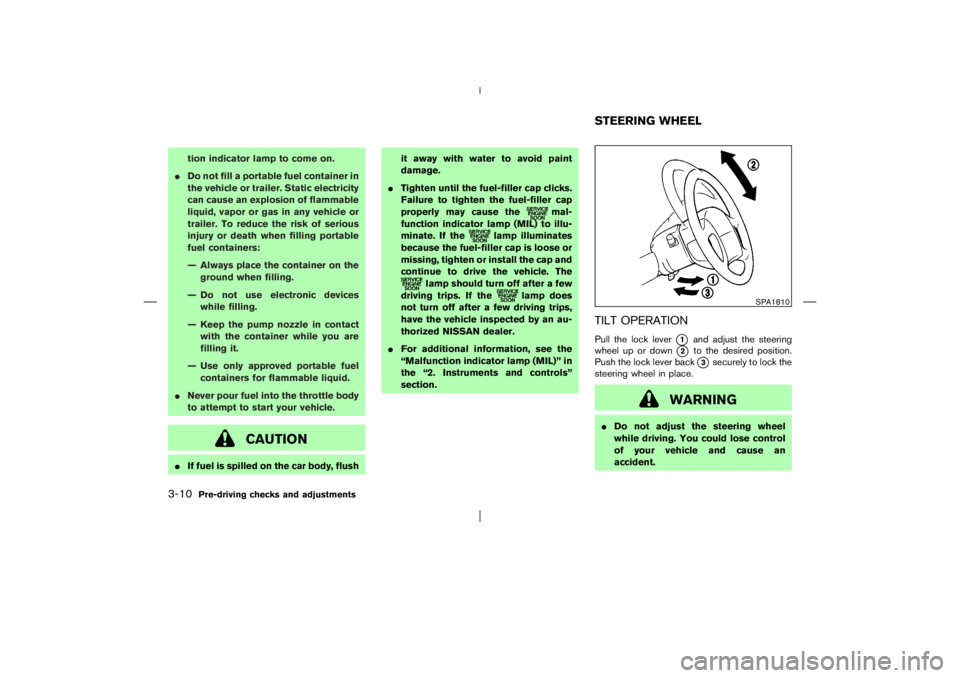Page 115 of 281

tion indicator lamp to come on.
�Do not fill a portable fuel container in
the vehicle or trailer. Static electricity
can cause an explosion of flammable
liquid, vapor or gas in any vehicle or
trailer. To reduce the risk of serious
injury or death when filling portable
fuel containers:
— Always place the container on the
ground when filling.
— Do not use electronic devices
while filling.
— Keep the pump nozzle in contact
with the container while you are
filling it.
— Use only approved portable fuel
containers for flammable liquid.
�Never pour fuel into the throttle body
to attempt to start your vehicle.
CAUTION
�If fuel is spilled on the car body, flushit away with water to avoid paint
damage.
�Tighten until the fuel-filler cap clicks.
Failure to tighten the fuel-filler cap
properly may cause the
mal-
function indicator lamp (MIL) to illu-
minate. If the
lamp illuminates
because the fuel-filler cap is loose or
missing, tighten or install the cap and
continue to drive the vehicle. The
lamp should turn off after a few
driving trips. If the
lamp does
not turn off after a few driving trips,
have the vehicle inspected by an au-
thorized NISSAN dealer.
�For additional information, see the
“Malfunction indicator lamp (MIL)” in
the “2. Instruments and controls”
section.
TILT OPERATIONPull the lock lever
�1
and adjust the steering
wheel up or down
�2
to the desired position.
Push the lock lever back�3
securely to lock the
steering wheel in place.
WARNING
�Do not adjust the steering wheel
while driving. You could lose control
of your vehicle and cause an
accident.
SPA1810
STEERING WHEEL
3-10
Pre-driving checks and adjustments
�
06.4.14/T30-J/V5.0
�
Page 177 of 281

�HEADED UPHILL WITH CURB:
�2
Turn the wheels away from the curband
move the vehicle back until the curb side
wheel gently touches the curb.
�HEADED UPHILL OR DOWNHILL, NO
CURB:
�3
Turn the wheels toward the side of the road
so the vehicle will move away from the center
of the road if it moves.
4. Turn the ignition key to the LOCK position
and remove the key.The power assisted steering uses a hydraulic
pump, driven by the engine, to assist steering.
If the engine stops or drive belt breaks, you will
still have control of the vehicle. However, much
greater steering effort is needed, especially in
sharp turns or at low speeds.
WARNING
If the engine is not running or is turned
off while driving, the power assist for
the steering will not work. Steering will
be much harder to operate.
BRAKING PRECAUTIONSThe brake system has two separate hydraulic
circuits. If one circuit malfunctions, you will still
have braking at two wheels.
Vacuum assisted brake
The brake booster aids braking by using engine
vacuum. If the engine stops, you can stop the
vehicle by depressing the brake pedal. However,
greater foot pressure on the brake pedal will be
required to stop the vehicle and the stopping
distance will be longer.
Wet brakes
When the vehicle is washed or driven through
water, the brakes may get wet. As a result, your
braking distance will be longer and the vehicle
may pull to one side during braking.
To dry brakes, drive the vehicle at a safe speed
while lightly tapping the brake pedal to heat-up
the brakes. Do this until the brakes return to
normal. Avoid driving the vehicle at high speeds
until the brakes function correctly.
Parking brake break-in
Break in the parking brake shoes whenever the
stopping effect of the parking brake is weakened
or whenever the parking brake shoes and/or
drums/rotors are replaced, in order to assure the
best braking performance.
POWER STEERING BRAKE SYSTEM
5-24
Starting and driving
�
06.4.14/T30-J/V5.0
�
Page 220 of 281
2. Add distilled water up to the UPPER LEVEL
�1.
3. Tighten cell plugs
�A.
JUMP STARTINGIf jump starting is necessary, see “Jump starting”
in the “6. In case of emergency” section. If the
engine does not start by jump starting, the
battery may have to be replaced. Contact a
NISSAN dealer.1. Power steering fluid pump
2. Water pump
3. Alternator
4. Crankshaft pulley
5. Air conditioner compressor
6. Drive belt auto-tensioner
WARNING
Be sure the ignition key is in the OFF or
LOCK position. The engine could rotateunexpectedly.
1. Visually inspect each belt for signs of unusual
wear, cuts, fraying, oil adhesion or looseness.
If the belt is in poor condition or loose, have
it replaced or adjusted by a NISSAN dealer.
2. Have the belts checked regularly for condi-
tion and tension.
SDI1480
SDI1632
DRIVE BELTS
Maintenance and do-it-yourself
8-17
�
06.4.14/T30-J/V5.0
�